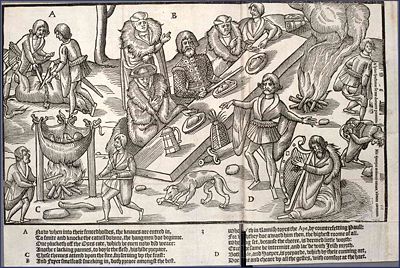
The Image of Irelande, with a Discoverie of Woodkarne
Encyclopedia

John Derricke
John Derricke was the writer and artist of The Image of Irelande, with a Discoverie of Woodkarne, a 1581 book documenting Sir Henry Sidney's campaigns in Ireland as Queen Elizabeth I's Lord Deputy...
, an English follower of Sir Henry Sidney
Henry Sidney
Sir Henry Sidney , Lord Deputy of Ireland was the eldest son of Sir William Sidney of Penshurst, a prominent politician and courtier during the reigns of Henry VIII and Edward VI, from both of whom he received extensive grants of land, including the manor of Penshurst in Kent, which became the...
, Elizabeth I's Lord Deputy of Ireland
Lord Deputy of Ireland
The Lord Deputy was the King's representative and head of the Irish executive under English rule, during the Lordship of Ireland and later the Kingdom of Ireland...
from 1565 to 1571 and 1575 to 1581. It contains a unique visual representation of 16th century Ireland
Ireland
Ireland is an island to the northwest of continental Europe. It is the third-largest island in Europe and the twentieth-largest island on Earth...
in sequential images. There is only one surviving complete copy, including all twelve woodcuts, which is held in Edinburgh University Library
Edinburgh University Library
Edinburgh University Library is one of the most important libraries of Scotland. It is located in Edinburgh. The University Library was moved in 1827 to William Playfair's Upper Library in the college building...
.
The book is a strong defence of Sidney's deputyship and his victories over the Irish. It begins with a long poem, giving a genealogical history of the Irish people and the English monarchy, justifying the right of the English to rule Ireland, and describing the conflicts between Sidney's forces and the Irish "woodkarne", landless guerrilla fighters who emerged from their mountain and forest retreats to plunder English settlements.
There follows a sequence of twelve double-page woodcut illustrations, measuring between 313 and 320mm wide and 180mm high, with accompanying verse
Verse (poetry)
A verse is formally a single line in a metrical composition, e.g. poetry. However, the word has come to represent any division or grouping of words in such a composition, which traditionally had been referred to as a stanza....
narration
Narrative
A narrative is a constructive format that describes a sequence of non-fictional or fictional events. The word derives from the Latin verb narrare, "to recount", and is related to the adjective gnarus, "knowing" or "skilled"...
and occasional captions and speech, telling the story of the subjugation of the Irish woodkarne rebels by Sir Henry Sidney, complete with hostile commentary on Irish customs, religious practice and even dress, ending with the submission of Turlough Luineach Ó Neill, king of Tyrone, in 1578.
The book's dedication to Sidney is signed at Dublin on 16 June 1578, indicating that Derricke completed the composition of the book in Ireland, and was almost certainly an eyewitness to the events he depicts. It is likely he returned to England with Sidney in 1578, and his illustrations were engraved between then and 1581, when the book was published in London
London
London is the capital city of :England and the :United Kingdom, the largest metropolitan area in the United Kingdom, and the largest urban zone in the European Union by most measures. Located on the River Thames, London has been a major settlement for two millennia, its history going back to its...
by John Day. Two of the plates are signed "ID", thus presumably engraved by Derricke himself, and four by "FD", perhaps a member of his family.
External links
- Woodcuts from The Image of Irelande, Edinburgh University Library
- The Image of Irelande, 1883 reprint with introduction and notes, downloadable in multiple formats from Archive.org
- Richard Marsh's explanation of plate 3
This article incorporates text fom

